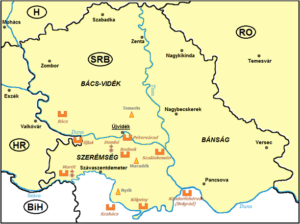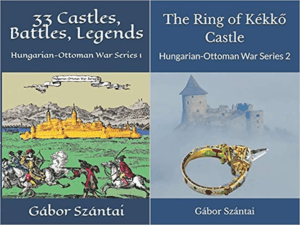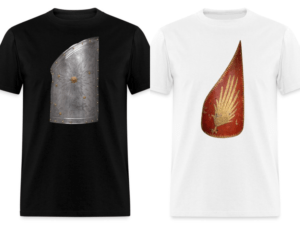
Source: partly from HM Hadtörténeti Intézet és Múzeum

Újlak (Croatian: Ilok) literally means “new dwelling place” in the Hungarian language and it used to be a frontier castle of southern Hungary during the Ottoman wars. It can be found in the easternmost corner of Croatia, it lies on a hill overlooking the Danube River. It is in the Tarcal mountains and it is also famous for its wine. The Romans settled there in the 1st or 2nd century and built Cuccium, the first border fortification on the Danube.
Location: https://tinyurl.com/4cd273a6

The Slavs settled here in the 6th century, and the Croats arrived here probably after the collapse of the second Avar Khanate. Some historians believe that the Avar people were the connections between the Huns of King Attila and the Hungarians of Árpád who arrived there in the 9th century. Regardless of this, Croats and Hungarians used to fight together against their common enemy for many long centuries.

The area was on the border of Hungary and it was later ruled by the Bulgarian Empire until it was included in the medieval Kingdom of Hungary. In the 12th and 13th centuries, the market-town of Újlak was mentioned in documents under various names (Iwnlak, Vilak, Vylok, Wyhok, Wylak). At the end of the 13th century, Hungarian kings gave the “Vylak castrum” to the powerful Csák noble family. In the 13th and 14th centuries, Újlak was the capital of Upper Syrmia (Szerémség) ruled by Csák Ugrin. The city was also the center of the Bishopry of Szerémség.

After 1354, the town of Újlak belonged to Garay Miklós and Pál (in Croatian references Gorjanski), and then to Újlaki Miklós and his descendants, among which was his great-grandson Miklós, and the last member of the Újlaki family was Lőrinc of Újlak. (Please note, that I use the Eastern name order for Hungarians where family names come first.) Garay Miklós, the Bán of Macsó, chased away the rebelling Horvát family in 1387.

Újlak had 10,000 inhabitants in the 14th century and thus it belonged to the biggest towns of the Kingdom of Hungary. After the famous siege of Nándorfehérvár (Belgrade) in 1456, Saint Giovanni da Capestrano (Kapisztrán János), the greatest hero of the siege next to Hunyadi János, died in Újlak during the same year. We can see his chapel next to the castle. More about the fights of Hunyadi:
https://www.hungarianottomanwars.com/1372-1490/hunyadis-first-large-battle-against-the-turks-1441/
Újlaki Miklós was the Ban (Duke) of All Slavonia from 1457-63, and his son, Lőrinc, was a Duke of Syrmia (Szerémség) from 1477 to 1524. After the death of his father, Újlaki Lőrinc could not inherit the title of King of Bosnia, but he could – without actual power – bear the title of Prince of Bosnia instead. Nevertheless, he was one of the most influential lords in the country, with extensive estates and the position of Ban (Duke) of Macsó (until 1492). He took part in the siege of Vienna, and in 1487, he helped to prepare the peace treaty with Emperor Frederick III (1452-1493).

Two years later, together with several potentates, he swore an oath to King Matthias that after his death, Corvin János would be enthroned. After the Battle of Csontmező (4 July 1490), he fled to Pécs and did not take part in the election and coronation of King Ulászló II of Hungary. In 1493, at the Diet, he was accused of treason as an enemy of Bakócz Tamás. According to Bonfini, he publicly called the king an ox.

Újlaki was charged with disloyalty, aggravated by his alleged actions against the royal tax collectors and allegations of conspiring with the Ottomans. All this was sufficient justification for the monarch to confront his political rival and his rival’s main circle of supporters. The royal troops besieged Újlak castle in December 1494, led by Drágfy, and subsequently forced the surrender of several of the prince of Bosnia’s strongholds in Slavonia and Szerémség (Sirmium). Early the following year, they captured Kaposvár, and finally the prince’s last stronghold, Németújvár.

Palatine Szapolyai István, his ally, did not go to war, so Lőrinc Újlaki was forced to go to the king and ask for mercy. On the advice of Bakócz, King Ulászló II granted him an amnesty, but at that time, he had not yet received back his confiscated property. In return for the support of the Chancellor and Perényi Imre, Újlaki ceded them considerable property, which, through a compromise, enabled him to rise to the baronial rank again.

This warfare is one of the most easily reconstructed events in late medieval Hungarian military history, as the Treasury accounts – and other contemporary sources – provide accurate information for research. The cost of the expedition is also known: according to a charter of the king dated February 1495, it cost more than 80,000 forints, in addition to the war expenses of the high priests and lords.

It was in Újlak, too, that Tomori Pál was elected as the Archbishop of Kalocsa. He was the General of King Lajos (Louis) II who advised the king of the seemingly good idea of destroying Suleiman’s army one by one at Mohács in 1526. He knew that they would not have a chance in an open battle if the Sultan could unite his army. Unfortunately, Suleiman had already united his army, so Tomori paid with his life for the poor recon reports he received. But before the Battle of Mohács, Újlak had to be taken by the enemy…

The army of Sultan Suleiman was marching toward Mohács, and they took the castles that got in their way one by one. They occupied Pétervárad by a heavy siege on 28 July 1526, then they turned toward their next target, Újlak castle. According to Perjés Géza, a Hungarian historian, the Ottomans wanted to fight a decisive battle with the Hungarian king’s army before the reinforcing Christian armies from Croatia and Transylvania could arrive.

The small castle of Újlak heroically repelled the enemy’s attack from 1 August to 8 August. However, Grand Vizier Ibrahim applied so much siege equipment and cannons against them that the defenders could not hold the castle for a very long time. They surrendered on 8 August. In the meantime, the smaller castles in the area were taken by the raiding Ottoman troops; most of them fell to them without a fight because the guards had fled. After taking Újlak, the army of Suleiman was able to reach the Dráva River without any resistance. The Ottoman army arrived at Eszék (Osiek) on 14 August.

Since 1526, the town has been under Ottoman rule. During the Ottoman rule, the town was mainly populated by Muslims. In 1566-69, Újlak had 238 Muslim and 27 Christian houses. A few years later, in 1572, it had 386 Muslim and just 18 Christian houses. In 1669, the population numbered 1,160 houses, and the town possessed two mosques. It was a so-called “kaza” center in the Sanjak of Syrmia, meaning that it belonged directly under the Sultan. According to Evlija Celebi, the Turkish historian and traveler, Újlak was the nicest town between Belgrade (Nándorfehérvár) and Buda, boasting more than 200 shops and several schools.
The Imperial Army first occupied Újlak in 1688, but the Ottomans recaptured it in 1690. In 1697, the Habsburg army definitively retook Újlak from the Ottomans, and it was the time when the Muslim population fled. After 1688, the Odelscalch family received the place from the Habsburg Emperor, who invited Christian settlers from Bosnia. They built a nice palace there, too.

The wine of Újlak has remained world-famous; even Queen Elisabeth was drinking it in the 1990s. According to the 1991 statistics, there were 6775 inhabitants in the town, 4248 of them Croatians, 1157 Slovakians (who had settled there in the 1860s), 484 Serbians, and 105 Hungarians. The town suffered a lot in the wars in the 1990s.

Source: partly from HM Hadtörténeti Intézet és Múzeum
Dear Readers, I can only make this content available through small donations or by selling my books or T-shirts:
Please, feel free to support me with a coffee here:
You can check out my books on Amazon or Draft2Digital, they are available in hardcover, paperback, or ebook:
https://www.amazon.com/dp/198020490X or at https://books2read.com/b/boYd81

My work can also be followed and supported on Patreon: Become a Patron!http://Become a Patron!
[wpedon id=”9140″]




Become a Patron!Send me a one-time donation via PayPal or "Buy me a Coffee":
Thank you very much, köszönöm szépen.